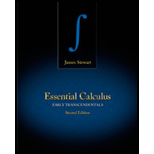
Essential Calculus: Early Transcendentals
2nd Edition
ISBN: 9781133112280
Author: James Stewart
Publisher: Cengage Learning
expand_more
expand_more
format_list_bulleted
Question
Chapter A, Problem 62E
To determine
To evaluate: The expression
Expert Solution & Answer
Want to see the full answer?
Check out a sample textbook solution
Students have asked these similar questions
exam review please help!
Can you solve question 3,4,5 and 6 numerical method use all data i given to you and teach me
Explain the key points of 11.5.2
Chapter A Solutions
Essential Calculus: Early Transcendentals
Ch. A - Prob. 1ECh. A - Convert from degrees to radians. 300Ch. A - Convert from degrees to radians. 9Ch. A - Convert from degrees to radians. 315Ch. A - Convert from degrees to radians. 900Ch. A - Convert from degrees to radians. 36Ch. A - Convert from radians to degrees. 4Ch. A - Convert from radians to degrees. 72Ch. A - Convert from radians to degrees. 512Ch. A - Convert from radians to degrees. 83
Ch. A - Convert from radians to degrees. 38Ch. A - Convert from radians to degrees. 5Ch. A - Find the length of a circular arc subtended by an...Ch. A - If a circle has radius 10 cm, find the length of...Ch. A - A circle has radius 1.5 m. What angle is subtended...Ch. A - Find the radius of a circular sector with angle...Ch. A - Draw, in standard position, the angle whose...Ch. A - Draw, in standard position, the angle whose...Ch. A - Draw, in standard position, the angle whose...Ch. A - Draw, in standard position, the angle whose...Ch. A - Draw, in standard position, the angle whose...Ch. A - Draw, in standard position, the angle whose...Ch. A - Find the exact trigonometric ratios for the angle...Ch. A - Find the exact trigonometric ratios for the angle...Ch. A - Find the exact trigonometric ratios for the angle...Ch. A - Find the exact trigonometric ratios for the angle...Ch. A - Find the exact trigonometric ratios for the angle...Ch. A - Find the exact trigonometric ratios for the angle...Ch. A - Find the remaining trigonometric ratios. sin=35,02Ch. A - Find the remaining trigonometric ratios. tan=2,02Ch. A - Find the remaining trigonometric ratios. sec=1.5,2Ch. A - Find the remaining trigonometric ratios....Ch. A - Find the remaining trigonometric ratios. cot=3,2Ch. A - Find the remaining trigonometric ratios....Ch. A - Find, correct to five decimal places, the length...Ch. A - Find, correct to five decimal places, the length...Ch. A - Find, correct to five decimal places, the length...Ch. A - Find, correct to five decimal places, the length...Ch. A - Prove each equation. (a) Equation 10a (b) Equation...Ch. A - Prove each equation. (a) Equation 14a (b) Equation...Ch. A - Prove each equation. (a) Equation 18a (b) Equation...Ch. A - Prove the identity. cos(2x)=sinxCh. A - Prove the identity. sin(2+x)=cosxCh. A - Prove the identity. sin(x)=sinxCh. A - Prove the identity. sincot=cosCh. A - Prove the identity. (sinx+cosx)2=1+sin2xCh. A - Prove the identity. secycosy=tanysinyCh. A - Prove the identity. tan2sin2=tan2sin2Ch. A - Prove the identity. cot2+sec2=tan2+csc2Ch. A - Prove the identity. 2csc2t=sectcsctCh. A - Prob. 51ECh. A - Prob. 52ECh. A - Prob. 53ECh. A - Prob. 54ECh. A - Prob. 55ECh. A - Prob. 56ECh. A - Prob. 57ECh. A - Prob. 58ECh. A - Prob. 59ECh. A - Prob. 60ECh. A - Prob. 61ECh. A - Prob. 62ECh. A - Prob. 63ECh. A - Prob. 64ECh. A - Prob. 65ECh. A - Prob. 66ECh. A - Prob. 67ECh. A - Prob. 68ECh. A - Prob. 69ECh. A - Prob. 70ECh. A - Prob. 71ECh. A - Prob. 72ECh. A - Prob. 73ECh. A - Prob. 74ECh. A - Prob. 75ECh. A - Prob. 76ECh. A - Prob. 77ECh. A - Prob. 78ECh. A - Prob. 79ECh. A - Prob. 80ECh. A - Prob. 81ECh. A - Prob. 82ECh. A - Prob. 83ECh. A - Prob. 84ECh. A - Prob. 85ECh. A - Prob. 86ECh. A - Prob. 87ECh. A - Prob. 88ECh. A - Find the area of triangle ABC, correct to five...
Knowledge Booster
Learn more about
Need a deep-dive on the concept behind this application? Look no further. Learn more about this topic, calculus and related others by exploring similar questions and additional content below.Similar questions
arrow_back_ios
SEE MORE QUESTIONS
arrow_forward_ios
Recommended textbooks for you
- Algebra & Trigonometry with Analytic GeometryAlgebraISBN:9781133382119Author:SwokowskiPublisher:Cengage
 Trigonometry (MindTap Course List)TrigonometryISBN:9781337278461Author:Ron LarsonPublisher:Cengage Learning
Trigonometry (MindTap Course List)TrigonometryISBN:9781337278461Author:Ron LarsonPublisher:Cengage Learning College Algebra (MindTap Course List)AlgebraISBN:9781305652231Author:R. David Gustafson, Jeff HughesPublisher:Cengage Learning
College Algebra (MindTap Course List)AlgebraISBN:9781305652231Author:R. David Gustafson, Jeff HughesPublisher:Cengage Learning

Algebra & Trigonometry with Analytic Geometry
Algebra
ISBN:9781133382119
Author:Swokowski
Publisher:Cengage

Trigonometry (MindTap Course List)
Trigonometry
ISBN:9781337278461
Author:Ron Larson
Publisher:Cengage Learning

College Algebra (MindTap Course List)
Algebra
ISBN:9781305652231
Author:R. David Gustafson, Jeff Hughes
Publisher:Cengage Learning
Double and Half Angle Formulas | Analytic Trig | Pre-Calculus; Author: Brian McLogan;https://www.youtube.com/watch?v=eTdKgsyCmHs;License: Standard YouTube License, CC-BY